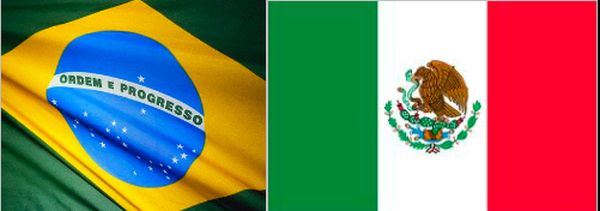Mexico City, Mexico - 2012 was a study in contrasts as far as Latin America’s two biggest economies, Brazil and Mexico, are concerned.
Brazil, which overtook Britain last year to become the world’s sixth largest economy, has been hit by weakening Chinese demand for commodities, while rival Mexico, the new darling of foreign investors, is posting increasingly strong growth.
The figures speak for themselves.
Brazil, for the last decade Latin America’s unchallenged behemoth, is expected to show growth of only one percent for 2012, down from 2.7 percent in 2011 and a sizzling 7.5 percent in 2010, according to official estimates.
By contrast, Mexico, the perennial underachiever in Latin America, is suddenly eying a position among the world’s 10 largest economies with projected growth of between 3.5 and four percent.
Mexico took a massive hit from the 2007-2008 financial crisis, thanks in large part to its proximity to the United States, but its economy contracted a whopping six percent in 2009
But a huge reduction in Mexico’s "country cost" — the cost of doing business there — sparked an impressive turnaround that attracted investment in its industrial sector, created jobs, and added value to exports.
Sebastian Briozzo, head of sovereign ratings at Standard & Poor’s for Latin America (the stock market index tracking Latin American stocks,) said the two countries have very different growth patterns.
"Brazil is a closed economy in which production growths are based on internal demand, particularly domestic consumption, and not so much on investment," he said. "Mexico on the other hand is more dependent on the United States' industrial sector."
Juan Jensen, head of macro-economics at the Brazilian consulting firm "Tendencias," attributed the slowdown in Brazil’s $2.5 trillion economy to a major loss of competitiveness reflected in salaries that far outpaced inflation.
"Brazil lost because of its higher production costs," Jensen said, adding that the Brazilian government’s tolerance of higher inflation and opaque fiscal policy had been problematic.
"This surely scared off foreign investors ... who find other countries, including Mexico, with better prospects for good returns on their investment," he said.
 |
Mexico, which has built on NAFTA since 1994 and now does more than 90 percent of its foreign dealings under free trade agreements, continues to lower its production costs - thereby making them competitive with anyone, including China.
"Mexico continues to offer cheap labor and has an infrastructure for some ‘durable goods’ such as automobiles, computers, and home appliances," said Octavio Gutierrez, chief economist at BBVA bank in Mexico City. "This enables it to quickly expand production for exports to the all-important US market and explains the relocation of industrial plants to Mexico as 'one of the pillars' of the country’s development," he added.
"The difference between Mexico and Brazil has to do with costs. Mexico has increased unit labor costs much less than Brazil has," Gutierrez said.
Brazil has recorded a fall in productive investment, down 4.5 percent, and 2.7 percent contraction in its industrial output, according to the National Confederation of Industry.
Meanwhile, Mexico is reaping the benefit of a slow but steady pickup in demand for its products in the United States. Its industry grew 4.2 percent between January and September this year compared with the same period in 2011.
Economists see the difference in foreign trade focus as the key factor in explaining the contrasting performances of the Latin American rivals.
"Brazil is almost returning to its model of the 1960s, which was to look inward, to be more protectionist and to subsidize companies," said Claudio Loser, former director of the Western Hemisphere Department at the International Monetary Fund who now heads the Latin American branch of the Centennial Group think tank.
"I think Mexico has an economy which overall is much more efficient and better integrated with the world than that of Brazil, which rested a bit on its laurels," he added.
Jensen agreed. "Mexico has opened its borders, signing free trade agreements, including with China. In so doing it imports cheap goods, adds value, and re-exports these goods to the United States," he said.
"Brazil does the opposite: It closes itself, tries to produce locally and ends up producing more expensive goods which it has a hard time re-exporting."


